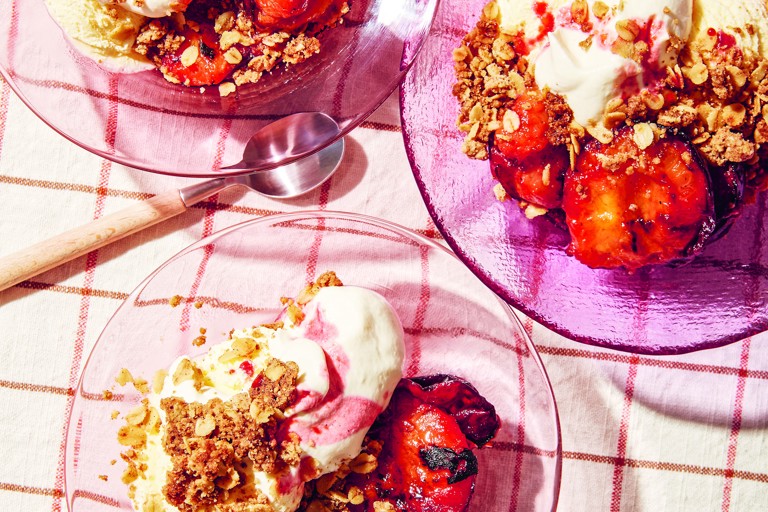Grilled plums, five-spice crumble and honey-rum cream
Plums are undeniably delicious raw, but when cooked on the barbecue they take on an extra dimension. They are best served simply, as they are here, with just a touch of rich crumble and barely-sweet cream.
This recipe is taken from Barbecue Days, Barbecue Nights by Helen Graves (Hardie Grant, £22), Photography by Robert Billington.
Helen says: 'I love a grilled stone fruit. It’s a handy technique for fruits that perhaps aren’t at their peak; at least, they’re not those you’d be precious about eating straight up to savour their perfect ripeness. Grilling brings out both sweetness and juice; softening and caramelising the fruit. I serve these plums with a quick crumble topping that’s warm with Chinese five-spice, and a softly whipped cream hiding a kicker of rum. I also find that adding one form of cream to a dessert immediately makes me want to add another, which is why I often serve both whipped cream and ice cream. You’ll never look back, I promise.'
Lighting your barbecue
Place a natural wool fire lighter on the base of your barbecue (remove the grill first), then fill up your chimney starter with lump wood charcoal. Light the fire lighter, then place your full chimney on top of it and wait for 5–10 minutes before tipping the coals into the base of the kettle.
Barbecue setup
There’s really only one setup your need to know about, and that’s a two-zone setup for ‘indirect cooking’. This just means that the coals are banked to one side of the barbecue creating a hot zone and a cooler zone. The hot zone can be used for searing and quick cooking, while the cooler zone is used for cooking larger bits of meat, for example, cooking things through more slowly and gently, and serves as a safe place to put things when they’re cooking too fast and/or flames are flaring up due to dripping fat.
The only time I really deviate from this setup is when I’m cooking wings, when I arrange the coals in the centre of the barbecue with an empty ring around the outside. It’s the same principle as above, but there’s just extra room to cook more wings evenly at the same time.
On the occasions that I specify heat level in a recipe, 'medium hot’ simply means adding more coals, while ‘medium-low’ means adding – you’ve guessed it – fewer.
Ingredients
Metric
Imperial
- 50g of unsalted butter, cold, cubed
- 50g of Demerara sugar
- 50g of plain flour
- 50g of rolled oats
- 1/2 tsp flaky sea salt
- 1 tbsp of Chinese five-spice powder
Plums
- 4 plums, large
- neutral oil, for brushing
- 2 tbsp of soft brown sugar, or any sugar will do
Cream
- 150ml of whipping cream
- 1 tbsp of runny honey
- 1 pinch of flaky sea salt
- 1 tbsp of dark rum
To serve
Equipment
- Barbecue
Method
Prepare a barbecue for two-zone cooking as described above, with medium heat
To make the crumble, heat the oven to 200°C (400°F/gas 6)
Combine the butter and sugar in a bowl and beat until combined with an electric whisk. Using your fingers, rub in the flour, oats, salt and five-spice – you’re looking for lots of uneven lumps. Spread it onto a baking tray and bake in the oven for 10–15 minutes, or until golden
- 50g of unsalted butter, cold, cubed
- 50g of Demerara sugar
- 50g of plain flour
- 50g of rolled oats
- 1/2 tsp flaky sea salt
- 1 tbsp of Chinese five-spice powder
Slice the plums in half and remove the stones, then brush each plum all over with oil. Place cut-side down over direct heat and cook the plums for 5 minute or so with the lid down and vents half closed, or until charred and soft
- 4 plums, large
- neutral oil, for brushing
Turn the plums over with tongs, then sprinkle them with the sugar. Close the lid again and cook for a couple of minutes more, or until the sugar is melted
- 2 tbsp of soft brown sugar, or any sugar will do
To cook indoors: Cook the plums cut side up under a hot grill for 10 minutes, or until soft and charred. Sprinkle with the sugar then return to the grill for a couple of minutes more
Using an electric whisk, whip the cream in a bowl until it’s beginning to thicken. Add the honey, salt and rum and continue whisking to soft peaks
- 150ml of whipping cream
- 1 tbsp of runny honey
- 1 pinch of flaky sea salt
- 1 tbsp of dark rum
Serve the plums with the crumble and cream, and ice cream
Get in touch
Please sign in or register to send a comment to Great British Chefs.


